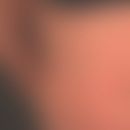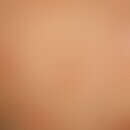Synonym(s)
HistoryThis section has been translated automatically.
DefinitionThis section has been translated automatically.
Group of genetically heterogeneous cornification disorders (Ichthys = fish) with mostly universal, abnormally dry and scaly skin. The palms of the hands and soles of the feet can also be affected. However, the palmoplantar keratoses do not primarily dominate the clinical picture.
For historical reasons, keratinization disorders are divided into:
- Ichthyoses (affecting the entire integument)
- Palmoplantar keratoses (here the palms of the hands and soles of the feet are mainly affected, extrapalmoplantar involvement is possible, but recedes in clinical appearance)
- Erythrokeratoderma (disseminated, clearly circumscribed keratoses that are accompanied or underlaid by a distinct erythema).
Ichthyoses can also be divided into:
- syndromic ichthyoses (integument + other organs are affected)
- and
- non-syndromal ichthyoses (only the integument is affected)
In syndromic ichthyoses, the "ichthyosis" acts as a monitoring sign. Its correct classification is important for clinical care on the one hand and for hereditary and clinical advice on the other. In the meantime, almost all ichthyoses have been genetically clarified.
In addition to genetic cornification disorders, acquired "ichthyosis-like" skin changes also occur(pseudoichthyoses), which can be triggered by a variety of underlying diseases or procedures: excessive washing procedures, malignancies (especially lymphomas), medication, renal insufficiency, infections (e.g. HIV), endocrinopathies (e.g. hypothyroidism). These reactive keratinization disorders can generally be diagnosed on the basis of visual diagnosis and medical history.
You might also be interested in
ClassificationThis section has been translated automatically.
Syndromic ichthyoses (varies according to Oji 2018)
X-linked ichthyosis syndromes
- X-linked (recessive) ichthyosis (XRI); syndromic forms (OMIM: 308700; 300500; 300533; mutation in STS=steroid sulfatase gene)
- Ichthyosis follicularis-alopecia-photophobia (IFAP) syndrome (OMIM: 308205; mutation in MBTPS2)
- Olmsted syndrome (OMIM:300918; mutations in TRPV3/MBTPS2)
- Conradi-Hünermann-Happle syndrome (OMIM:302960; mutation in EBP)
- MEND syndrome (OMIM: 300960; mutation in EBP)
Autosomal ichthyosis syndromes with conspicuous hair changes
- Comél-Netherton syndrome (OMIM:256500; mutation in SPINK5)
- SAM syndrome (severe dermatitis-multiple allergies-metabolic failure to thrive) (OMIM:615508; mutations in desmoglein-1 and desmoplakin gene)
- Ichthyosis-hypotrichosis syndrome (OMIM:602400; mutation in ST14)
- Neonatal ichthyosis-sclerosing cholangitis (OMIM:607626; mutation in CLDN1 (claudin1)
Autosomal ichthyosis syndromes with conspicuous neurological symptoms (neuro-ichthyoses)
- Refsum syndrome (OMIM:266500; mutations in PHYH and PEX7)
- Multiple sulphatase deficiency (OMIM:272200; mutation in SUMF1)
- Sjögren-Larsson syndrome (270200; mutation in ALDH3A2)
- Gaucher syndrome type 2 (OMIM:230900; mutation in GBA)
- Ichthyosis-spastic quadriplegia-mental retardation -ISQMR(OMIM:614457; mutation in ELOVLA)
- Chanarin-Dorfman syndrome (OMIM:604780; mutation in ABHD5)
- Trichothiodystrophy (OMIM:601675; mutation in ERCC2)
- Trichothiodystrophy (non-congenital forms (OMIM:275550; 211390; 60675)
- Cerebral dysgenesis-neuropathy-ichthyosis-keratoderma palmoplantaris (CEDNIK syndrome) (OMIM:609528; mutation in SNAP29)
- Arthrogryposis-renal dysfunction-cholestasis (OMIM:208085; mutation in VPS33B gene)
Autosomal ichthyosis syndromes with deafness
- Keratitis-ichthyosis-deafness (KID ) syndrome (OMIM:148210; mutation in GJB2)
- Autosomal recessive keratoderma-ichthyosis-deafness syndrome (ARKID); biallelic mutations in VPS33B)
- Mental retardation-enteropathy-deafness-neuropathy-ichthyosis-keratoderma (MEDNIK syndrome) (OMIM:609313; mutation in AP1S1)
Autosomal ichthyosis syndrome with respiratory symptoms (already present at birth)
- Ichthyosis-prematurity syndrome (OMIM:608649; mutation in SLC27A4)
ClinicThis section has been translated automatically.
S.u. and the respective clinical picture.
HistologyThis section has been translated automatically.
Classification of ichthyoses according to their histological reaction pattern (var. according to D. Metze and H. Traupe 2016)
Orthohyperkeratosis with reduced or absent str. granulosum
- Ichthyosis vulgaris group (see above).
- Ichthyosis acquisita (acquired ichthoysis-like conditions)
- Refsum syndrome (+lipid vacuoles in basal keratinocytes)
- Dorfmann-Chanarin syndrome
- Trichothiodystrophy syndrome
- Conradi-Hünermann syndrome
- Harlequin ichthyosis (+massive hyperkeratosis, parakeratosis possible)
Orthohyperkeratosis with well developed str. granulosum
- Ichthyosis vulgaris, autosomal dominant (ADI)
- Ichthyosis vulgaris, X-linked recessive (XRI)
- Congenital atrichia
Orthohyperkeratosis with parakeratosis, normal or prominent str. granulosum
- Sjögren-Larsson syndrome (+church-tower-like eruptions)
- Erythrokeratoderma
- HID/KID syndrome
- Loricrin keratoderma
- KLICK syndrome
Epidermolytic hyperkeratosis
- Epidermolytic ichthyosis (ichthyosis Brocq)
- Anular epidermolytic ichthyosis
- Superficial epidermolytic ichthyosis (formerly: ichthyosis bullosa Siemens)
Epidermal keratinocytes binucleate with perinuclear vacuoles
- Congenital reticular ichthyosiform erythroderma (with parakeratosis)
- Ichthyosis Curth-Macklin (without parakeratosis)
Psoriasiform epidermal reaction
TherapyThis section has been translated automatically.
See below the respective clinical picture.
See below Ichthyoses, Therapy
TablesThis section has been translated automatically.
Therapeutic guidelines for frequent ichthyosis
Active ingredients |
ichthyosis vulgaris |
X-linked recessive ichthyosis |
Erythrodermia congenitalis ichthyosiformis non-bullosa |
Ichthyosis lamellosa |
Erythrodermia congenitalis ichthyosiformis bullosa |
ichthyosis bullosa |
|
Keratolytic measures |
Salicylic acid |
++ |
++ |
- |
+ |
- |
+ |
Urea |
+++ |
+++ |
+++ |
+++ |
+++ |
+++ |
|
| |||||||
Hydration |
Urea |
+++ |
+++ |
+++ |
++ |
+++ |
++ |
Lactic acid |
+++ |
+++ |
++ |
+ |
+ |
(++) |
|
| |||||||
Local retinoids |
Tretinoin |
(+) |
++ |
- |
+ |
- |
+/- |
Isotretinoin |
- |
- |
- |
++ |
- |
+/- |
|
| |||||||
Systemic retinoids |
Acitretin |
(+) |
++ |
(++) |
+++ |
++ |
++ |
LiteratureThis section has been translated automatically.
- Buxman M et al. (1986) Therapeutic activity of lactate 12% lotion in the treatment on ichthyosis. Active versus vehicle and active versus a petrolatum cream. J Am Acad Dermatol 15: 1253-1258
- DiGiovanna JJ, Robinson-Bostom L (2003) Ichthyosis: etiology, diagnosis, and management. Am J Clin Dermatol 4: 81-95
- Dumenigo A et al. (2022) CYP4F22-Related Autosomal Recessive Congenital Ichthyosis: Clinical Presentation. Cureus 14:e22272.
- Lorry AC (1777) Tractatus de morbis cutaneis. P. Guillelmum Cavelier, Paris, pp. 167-184
- Metze H et al (2016) Hereditary keratinization disorders and epidermal malformations. In: Cerroni L et al. Histopathology of the skin. Springer-Verlag Berlin Heidelberg p.407
- Niemi KM et al (1991) Recessive ichthyosis congenita type II. Arch Dermatol Res 283: 211-218
- Oji V(2018) Ichthyoses. In: Braun-Falco`s Dermatology, Venereology Allergology G. Plewig et al. (Eds.) Springer Verlag S 1066-1067
- Oji V et al. (2010) Revised nomenclature and classification of inherited ichthyoses: results of the First Ichthyosis Consensus Conference in Sorèze 2009. J Am Acad Dermatol 63: 607-641.
- Swanbeck G (1989) Urea as a monotherapeutic agent for dry skin. Dermatologist 40: 42-43
- Thauvin-Robinet C et al. (2005) X-linked recessive ichthyosis in a girl: strategy for identifying the causal mechanism. Br J Dermatol 152: 191-193
- Vincent QJI, Traupe H (2006) Ichthyoses: Differential diagnosis and molecular genetics. Eur J Dermatol 16: 349-359
- Willan R (1808) Ichthyosis. In: On cutaneous disease. Barnard, London, Vol.1, Chapter 4
Incoming links (45)
Acanthosis; Acitretin; Acrodermatitis enteropathica; ALOXE3 Gene; Anhidrotic ectodermal dysplasia; Bath oils; Brine bath; Chondrodysplasia calcificans congenita; Collodion baby; Comel-netherton syndrome; ... Show allOutgoing links (59)
ABHD5 Gene; ALDH3A2 Gene; Anular epidermolytic ichthyosis; AP1S1 Gene; ARKID syndrome; Arthrogryposis-renal dysfunctional cholestasis; Atrichia congenita with horny cysts; CEDNIK syndrome; Child syndrome; Chondrodysplasia calcificans congenita; ... Show allDisclaimer
Please ask your physician for a reliable diagnosis. This website is only meant as a reference.









